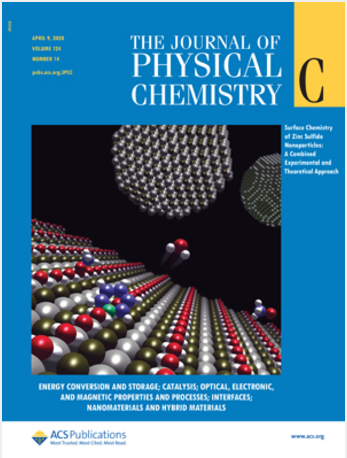CrCl3单层中平面内自旋声子耦合的理论拉曼研究
IF 3.3
3区 化学
Q2 CHEMISTRY, PHYSICAL
引用次数: 0
摘要
拉曼光谱是表征二维(2D)磁性材料的关键技术,为其结构和磁性提供了有价值的见解。这种方法在三氯化铬(CrCl3)的研究中尤其重要,这种材料由于其独特的磁性行为而引起了相当大的关注。在这项研究中,我们只考虑最近邻交换相互作用,系统地研究了2D CrCl3的磁拉曼响应,并观察到Eg2拉曼峰在不同磁构型下的显著频移约为20 cm-1。这种转变主要归因于自旋声子耦合,从而提供了一种可靠的方法来区分各种磁结构。Eg2拉曼峰与Cr和Cl原子的集体振动有关,Cr原子在观察到的磁构型差异中起主导作用。即使考虑到更复杂的磁结构,比如包括次近邻和第三近邻相互作用,近邻交换相互作用仍然是最重要的。这种优势使得Eg2峰可以有效地解释为简单磁构型的叠加。此外,我们还探讨了外应变和载流子掺杂对二维CrCl3拉曼光谱的影响。在外双轴应变作用下,Eg2峰出现异常频移。电子掺杂对拉曼光谱有显著影响,而空穴掺杂对拉曼光谱的影响很小。重要的是,平面内自旋声子耦合在很大程度上不受晶体厚度、晶体相位或层间磁相互作用的影响。这些发现增强了我们对CrCl3中固有自旋声子耦合的理解,并为探索和设计二维材料的磁性奠定了坚实的基础。本文章由计算机程序翻译,如有差异,请以英文原文为准。

Theoretical Raman Study of In-Plane Spin–Phonon Coupling in a CrCl3 Monolayer
Raman spectroscopy is a crucial technique for characterizing two-dimensional (2D) magnetic materials, offering valuable insights into their structural and magnetic properties. This method is particularly significant in the study of chromium trichloride (CrCl3), a material that has garnered considerable attention due to its unique magnetic behavior. In this study, by considering only the nearest neighbor exchange interactions, we systematically investigated the magnetic Raman response of 2D CrCl3 and observed a notable frequency shift of approximately 20 cm–1 in the Eg2 Raman peak across different magnetic configurations. This shift is primarily attributed to spin–phonon coupling, thereby providing a reliable means to distinguish between various magnetic configurations. The Eg2 Raman peak is associated with the collective vibrations of Cr and Cl atoms, with Cr atoms playing a dominant role in the observed differences between magnetic configurations. Even when considering more complex magnetic configurations, such as including next-nearest and third-nearest neighbor interactions, nearest neighbor exchange interactions remain the most significant. This predominance allows the Eg2 peak to be effectively interpreted as a superposition of simpler magnetic configurations. Additionally, we explored the effects of external strain and carrier doping on the Raman spectrum of 2D CrCl3. Under external biaxial strain, the Eg2 peak exhibits anomalous frequency shifts. Electron doping significantly influences the Raman spectra, whereas hole doping has only minimal effects. Importantly, the in-plane spin–phonon coupling remains largely unaffected by variations in crystal thickness, crystal phase, or interlayer magnetic interactions. These findings enhance our understanding of the intrinsic spin–phonon coupling in CrCl3 and establish a robust foundation for exploring and engineering the magnetic properties of 2D materials.
求助全文
通过发布文献求助,成功后即可免费获取论文全文。
去求助
来源期刊

The Journal of Physical Chemistry C
化学-材料科学:综合
CiteScore
6.50
自引率
8.10%
发文量
2047
审稿时长
1.8 months
期刊介绍:
The Journal of Physical Chemistry A/B/C is devoted to reporting new and original experimental and theoretical basic research of interest to physical chemists, biophysical chemists, and chemical physicists.
 求助内容:
求助内容: 应助结果提醒方式:
应助结果提醒方式:


